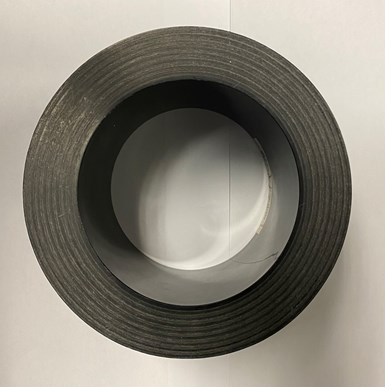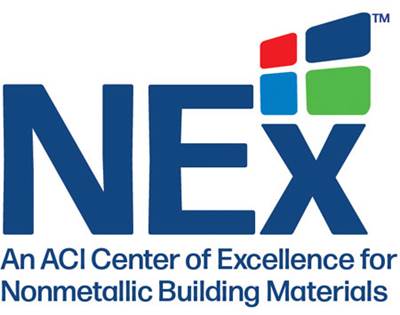Share
Read Next

In an era of relentless technological advancement, the world of composites has already witnessed significant development. Yet the opportunities for further progress are compelling, particularly within the oil and gas and construction industries.
In the oil and gas industry, composites have already found new purpose as an alternative to carbon steel alloy, the predominant material used in the sector. The promise of lower lifecycle costs and increased resistance to corrosion has inspired global energy company Aramco (Dhahran, Saudi Arabia) to deploy approximately 10,000 kilometers of nonmetallic pipe across its network for water, oil and gas applications. This includes reinforced thermoplastic pipe (RTP), reinforced thermosetting resin (RTR) pipe and thermoplastic lined pipe. The company commenced large-scale deployment of nonmetallic pipe in 2016, and now advances in another nonmetallic material, carbon fiber (CF) — first deployed by Aramco in 2018 — all of which indicate this could be an essential component moving forward.
Since then, Aramco has begun using CF-based composite materials in multiple applications across its operations, achieving a wide range of practical benefits and cost savings due to faster installation, immunity to corrosion and lower maintenance and operational costs.
Benefits of carbon fiber
CF’s inherent thermo-mechanical properties, as well as its high strength-to-weight ratio and high chemical resistance, make it ideal for industries that need lightweight components, a lower coefficient of thermal expansion, electrical conductivity and chemical inertness. Its superior performance in harsh and challenging environments continues to enable composites innovations across many sectors, including oil and gas applications; CF-reinforced concrete, bridges, decking, cladding and structures such as the Makkah Clock Tower within the building and construction industry; pressure vessels for hydrogen-powered transportation; wind turbines; and numerous applications in the auto and aerospace industries. Within automotive, Aramco is engaging with key stakeholders to influence the design of new vehicles, developing innovative CF technology to replace steel and aluminum, aiming for increased efficiency across design and assembly processes.
High production costs have limited the use of CF in some industries, but increased demand has seen the price come down over the past eight years — from $30 per kilogram in 2012 to around $20 per kilogram today for standard-grade CF, depending on order sizes and contract terms.1,2
“CF composites have strong potential to bring greater value to many industrial sectors. By working together with technology providers and industry leaders, we aspire to drive the deployment of cutting-edge, oil-based carbon fiber-based composite technologies in various applications in building and construction, automotive and renewables, in addition to oil and gas,” notes Abdullah Humaid, consulting services department manager at Aramco.
Increasing composite applications for oil and gas
One example is CF-reinforced, bonded nonmetallic pipe — known as thermoplastic composite pipe (TCP). For the first time, in 2018, Aramco deployed TCP as a gooseneck onshore wellhead riser in a high-sour crude operation containing high aromatic content (~50%). The TCP riser features improved flexibility when compared to carbon steel, as well as higher fatigue resistance and thermal insulation. With a pressure rating of 3,000 pounds per square inch gauge (PSIG), this unique application reduced long lead times for fabricating a carbon steel wellhead riser after rig release, and overcomes difficulties associated with workover, such as the need to refabricate spools due to orientation or height changes in the Christmas Tree (an assembly that regulates well production).

Beyond risers, CF composites also have a role to play in the repair of onshore and offshore carbon steel pipelines, which become more prone to defects and failures with age. CF composite repairs involve no hot work, no shutting down of the line and have a shorter lead time when compared with traditional metallic solutions. Aramco has applied CF composites in rig-less surface casing repairs, which expedites the turnaround time, restoring well integrity swiftly and achieving a significant cost saving.
In addition, 1.5 kilometers of reinforced thermosetting resin (RTR) pipe with embedded CF is deployed to supply diesel oil at an Aramco facility. This conductive, CF-embedded RTR pipe has been installed using a lamination jointing method to safely dissipate any static electricity build up. RTR pipeline helps ensure integrity since it does not encounter any internal or external corrosion.
Aramco is well placed to capitalize on the potential of CF for use in key applications in its own facilities. And while CF manufacture is energy-intensive, its beneficial qualities make up for it: CF-based composite pipe is light, spoolable and there is limited need for corrosion management and inspection.
Beyond its own operations, Aramco is now working with vendors to introduce state-of-the-art, CF-based composite technologies to the broader oil and gas sector — including products for onshore, offshore and downhole applications. And we see opportunities to expand deployment in other sectors, working together with technology providers and industry leaders.
Looking beyond oil and gas, Aramco’s scientists and researchers are exploring ways to further reduce the cost and expand opportunities for wider deployment of CF composites in various markets. Collaboration is also key; for example, Aramco has partnered with Baker Hughes (Houston, Texas, U.S.) in a 50/50 joint venture named Novel, that will initially produce RTP, but which could potentially expand to a broader range of nonmetallic products including CF composites.
While reducing costs remains key to increasing the potential of carbon fiber, adapting new production methods — like plasma oxidation technology 3 and developing a low-cost and high-yield precursor and highly reactive resin1 — may open up the potential for composites in market segments where it previously has been out of reach. That is why Aramco continues to explore opportunities in nonmetallics, including CF — laying the groundwork for a material that promises to be a key ingredient in future development.
References:
1 Carbon Composite are Becoming Competitive and Cost Effective-White Paper, Sharma R., Simha, T.. Rao, K.P. and Ravi, K., White Paper, Infosys, 2018
2 http://4mio.com/carbon-fiber/
3 https://www.compositesworld.com/articles/getting-carbon-fiber-cost-down, 2018
About the Authors
Waleed L. Al-Otaibi
Al-Otaibi is Nonmetallic Engineering Division head and PMO at Aramco. He is responsible for managing the implementation of Aramco’s nonmetallic business strategy with a focus on expanding nonmetallic deployment in oil and gas and other industrial sectors. He began his career at Aramco in 2003 as a materials engineer, and has 18 years of experience in technical and managerial roles. He holds bachelor’s degrees in mechanical engineering and economics from Colorado School of Mines, and holds a Master’s degree in material science and engineering from MIT and an MBA from King Fahd University of Petroleum and Minerals (KFUPM).
Anwar Parvez
Parvez is lead SME and engineering specialist in Nonmetallic Composite Engineering at Aramco. He has nearly 20 years of experience as a consultant, R&D and project engineer, and has worked internationally in Canada, Singapore, Bangladesh and Saudi Arabia. Parvez worked as a nonmetallic technical lead in numerous multi-billion dollar oil and gas projects for onshore, offshore and downhole, and he has led and contributed to numerous R&D projects. He holds a Bachelor’s degree in mechanical engineering from Khulna University of Engineering and Technology, and two Master’s degrees in mechanical engineering from Nanyang Technological University and Concordia University.
Related Content
Sulapac introduces Sulapac Flow 1.7 to replace PLA, ABS and PP in FDM, FGF
Available as filament and granules for extrusion, new wood composite matches properties yet is compostable, eliminates microplastics and reduces carbon footprint.
Read MoreInfinite Composites: Type V tanks for space, hydrogen, automotive and more
After a decade of proving its linerless, weight-saving composite tanks with NASA and more than 30 aerospace companies, this CryoSphere pioneer is scaling for growth in commercial space and sustainable transportation on Earth.
Read MoreThe potential for thermoplastic composite nacelles
Collins Aerospace draws on global team, decades of experience to demonstrate large, curved AFP and welded structures for the next generation of aircraft.
Read MoreNatural fiber composites: Growing to fit sustainability needs
Led by global and industry-wide sustainability goals, commercial interest in flax and hemp fiber-reinforced composites grows into higher-performance, higher-volume applications.
Read MoreRead Next
Aramco, ACI launch new center to develop, promote nonmetallic material use for construction
Center of Excellence for Nonmetallic Building Materials to develop, disseminate and adopt consensus-based standards for concrete design, construction and materials.
Read MorePlant tour: Daher Shap’in TechCenter and composites production plant, Saint-Aignan-de-Grandlieu, France
Co-located R&D and production advance OOA thermosets, thermoplastics, welding, recycling and digital technologies for faster processing and certification of lighter, more sustainable composites.
Read MoreAll-recycled, needle-punched nonwoven CFRP slashes carbon footprint of Formula 2 seat
Dallara and Tenowo collaborate to produce a race-ready Formula 2 seat using recycled carbon fiber, reducing CO2 emissions by 97.5% compared to virgin materials.
Read More






















